Carp stuffed with cabbage is a delicious Eastern European dish that's perfect for festive occasions. You start by cleaning and deboning fresh carp, then blanch cabbage leaves for easy rolling. Mix sautéed onions, garlic, and your choice of rice or breadcrumbs to create a flavorful stuffing. You'll bake it all to perfection, creating a hearty meal that symbolizes prosperity and good fortune. Discover the cooking steps and variations to make it uniquely yours.
History
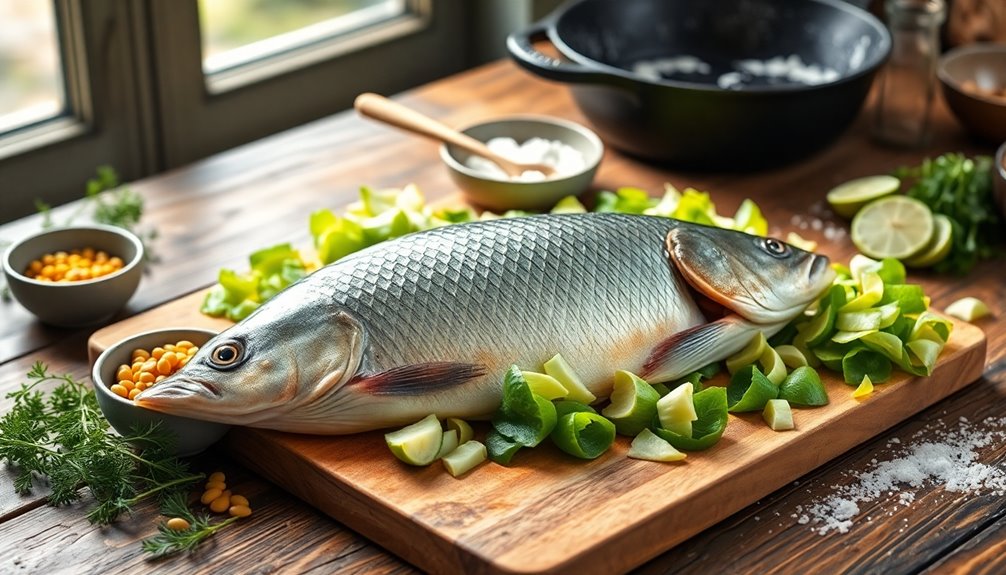
When you explore the history of stuffed carp, you'll find it's a beloved dish in Eastern European cultures, especially during festive occasions like Christmas Eve in Poland and Hungary.
This dish not only highlights the cultural significance of fish but also symbolizes prosperity and good fortune for the coming year. Traditionally, carp is prepared as part of the meatless feast during Advent, showcasing the region's agricultural practices through locally sourced ingredients.
The preparation often features cabbage, which plays a crucial role in the stuffing, and variations have emerged over time, with different spices and herbs added to suit local tastes.
You'll see how stuffed cabbage rolls can inspire creativity in recipe adaptations, reflecting the culinary innovations of the region.
Recipe
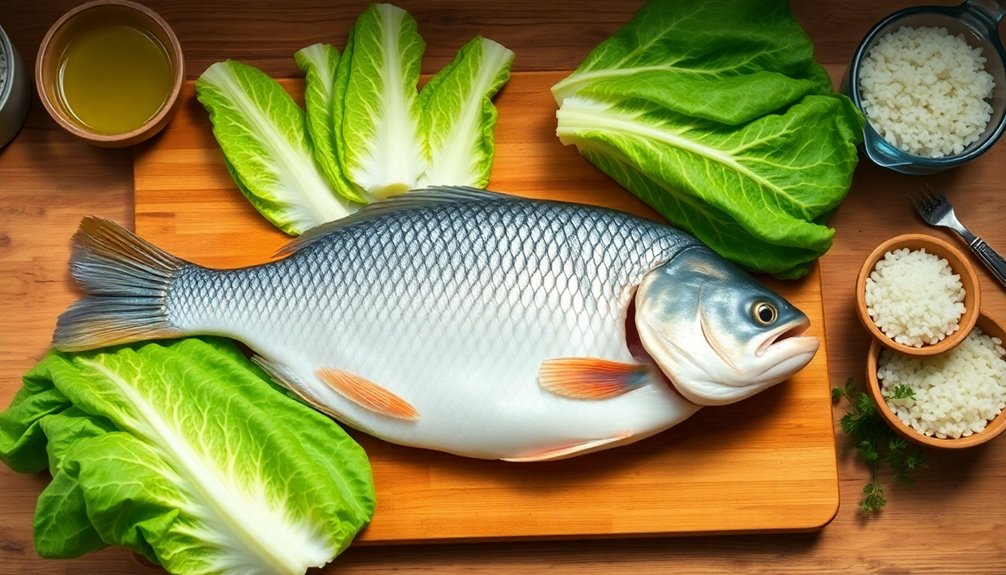
Preparing stuffed carp requires some attention to detail, but the end result is well worth the effort. Start by selecting a fresh carp, which should be cleaned and deboned to create the perfect vessel for the flavorful stuffing. The cabbage leaves must be blanched to ensure they're soft enough to wrap around the filling. With the right ingredients and a little patience, you can create a dish that isn't only visually appealing but also bursting with flavor.
Ingredients:
- 1 whole carp, cleaned and deboned
- 1 medium head of cabbage
- 2 tablespoons olive oil
- 1 large onion, finely chopped
- 2 cloves garlic, minced
- 1 cup cooked rice or breadcrumbs
- 1 teaspoon dried thyme
- 1 teaspoon paprika
- Salt and pepper to taste
- Fresh herbs for garnish (optional)
Cooking Instructions:
Begin by preheating your oven to 350°F (175°C). In a large pot, bring water to a boil and blanch the cabbage leaves for about 2-3 minutes until they're soft and pliable. Remove and set aside.
In a skillet, heat olive oil over medium heat, then add chopped onions and minced garlic, sautéing until they're translucent. In a bowl, combine the sautéed mixture with cooked rice or breadcrumbs, thyme, paprika, salt, and pepper.
Lay out the cabbage leaves and spoon the stuffing mixture onto each leaf, wrapping them around the filling and placing them seam-side down in a baking dish. Once all the carp is stuffed, add a little broth or water to the bottom of the dish, cover with foil, and bake for about 45 minutes.
Extra Tips:
When selecting your carp, aim for a fish that's firm and smells fresh – this will enhance the overall flavor of the dish.
For a twist, consider adding grated carrots or chopped bell peppers to the stuffing mixture for added color and nutrition. If you prefer a lighter dish, steaming the stuffed carp instead of baking can provide a tender texture while allowing the flavors to shine through.
Lastly, serve the dish with a drizzle of the cooking liquid or a light sauce to elevate the presentation and taste.
Cooking Steps

To start making your stuffed carp, you'll need to prepare the cabbage leaves by blanching them until they soften.
Next, chop the vegetables and mix them with rice, herbs, and the seafood to create a flavorful filling.
Finally, roll the mixture tightly in the cabbage leaves for a delicious dish that's ready to bake.
Step 1. Prepare Cabbage Leaves Carefully

Blanching the cabbage leaves in a large pot of salted boiling water for 3-4 minutes softens them, making it easier for you to roll without tearing.
Once blanched, transfer the leaves immediately to an ice water bath. This halts the cooking process and preserves their vibrant color.
After they've cooled, carefully remove the leaves from the ice water and pat them dry with a paper towel to eliminate excess moisture.
When you're ready to assemble the rolls, place the filling in the center of each leaf. Fold the sides inward and roll tightly from the stem end to secure the filling.
If the leaves don't hold their shape, use plastic wrap to keep them intact until you're ready to cook.
Step 2. Chop Vegetables for Filling
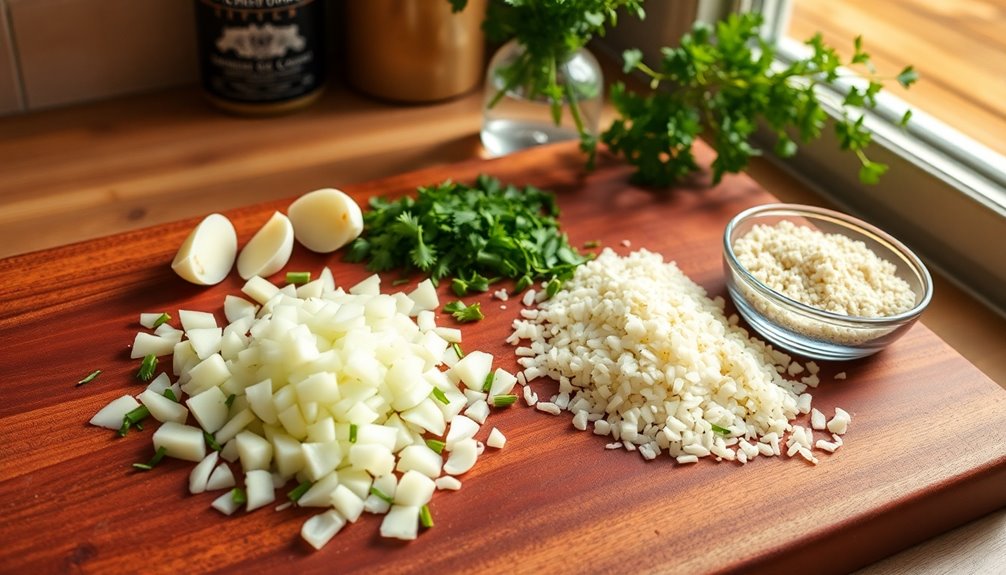
Once you've prepped those cabbage leaves, it's time to focus on the filling.
Start by selecting fresh vegetables like bell peppers, onions, and celery. These will form a flavorful base for your stuffing. Chop the vegetables into small, uniform pieces to ensure even cooking and a consistent texture.
Next, heat some olive oil in a skillet over medium heat and sauté the chopped vegetables for about 5-7 minutes, until they're tender and fragrant. Don't forget to season them with salt, pepper, and herbs to enhance their flavor.
Once they're nicely sautéed, you'll mix these vegetables with cooked rice or breadcrumbs to create a hearty filling that perfectly complements the carp.
Step 3. Mix Rice and Herbs
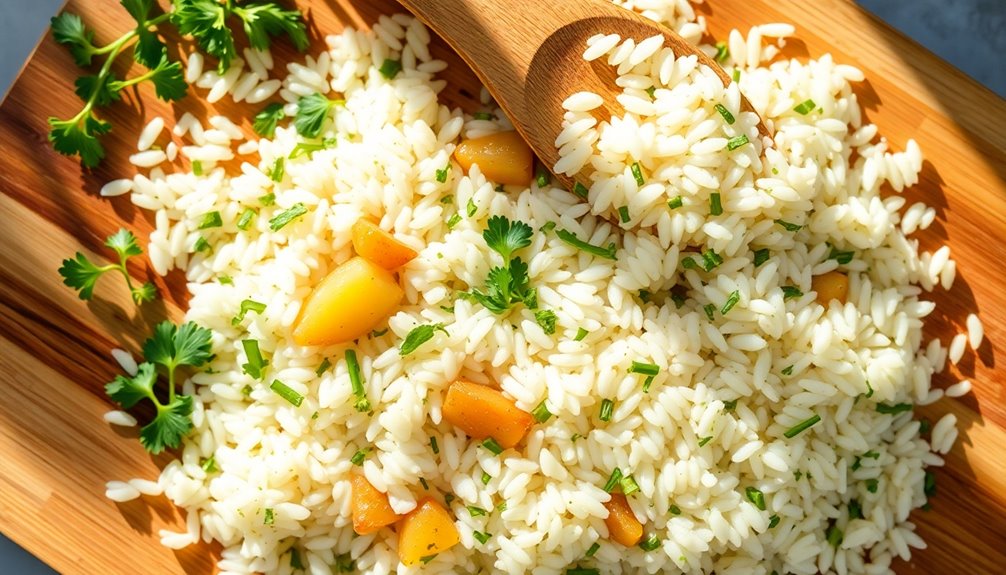
Start by cooking your rice according to the package instructions, making sure it's fluffy and not overcooked.
Once done, transfer the rice to a large bowl.
Add finely chopped fresh herbs like parsley, dill, and chives for a burst of flavor.
To enhance the mixture, incorporate sautéed onions and garlic, allowing their aromatic essence to blend with the rice.
Season the mixture generously with salt and pepper, and feel free to add optional spices such as paprika or lemon zest to elevate the taste further.
Stir everything together until well combined.
This rice and herb mixture will serve as a delicious filling for your carp, creating a delightful balance of flavors in your dish.
Step 4. Incorporate Seafood Into Mixture
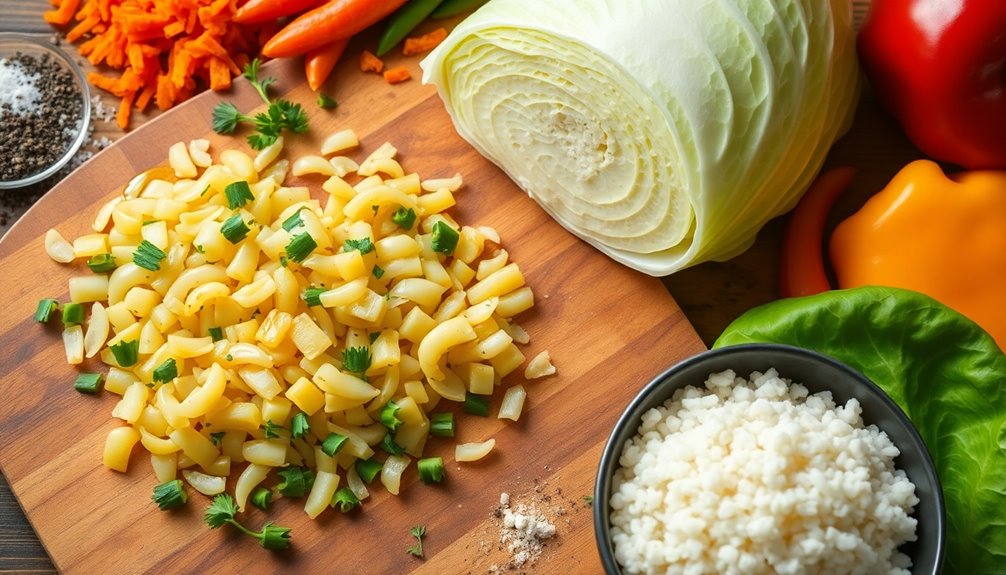
To elevate your rice and herb mixture, incorporating seafood adds a delightful twist that enhances both flavor and texture.
Start by finely chopping shrimp or crab meat, then combine it with your cooked rice or couscous.
Next, sauté shallots, garlic, and bell peppers in a pan to create a flavorful base. Once softened, mix these ingredients with the seafood, ensuring you season with salt and add herbs like dill or parsley for a fresh note.
A splash of lemon juice will brighten the dish.
After preparing your seafood mixture, it's ready for stuffing into cabbage leaves.
Step 5. Rolling the Cabbage Leaves
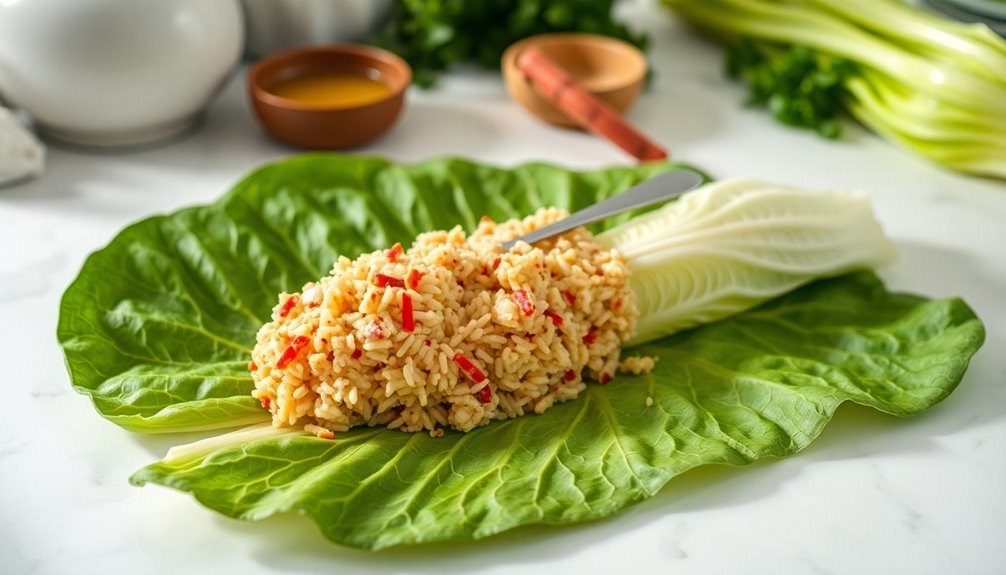
Blanching large cabbage leaves is the first step to making rolling easier and ensuring your stuffed carp holds together beautifully. Start by boiling salted water, adding the leaves for 3-4 minutes until softened, then quickly transfer them to ice water to halt the cooking process.
Lay a blanched leaf flat on a clean surface, placing a spoonful of your prepared carp filling in the center. Fold the sides inward, then roll from the bottom to the top, securing the filling inside.
If the roll isn't holding its shape, use plastic wrap or kitchen twine to tighten it. Finally, arrange your cabbage rolls seam side down in a steamer or casserole dish for cooking, whether by steaming or baking.
Final Thoughts
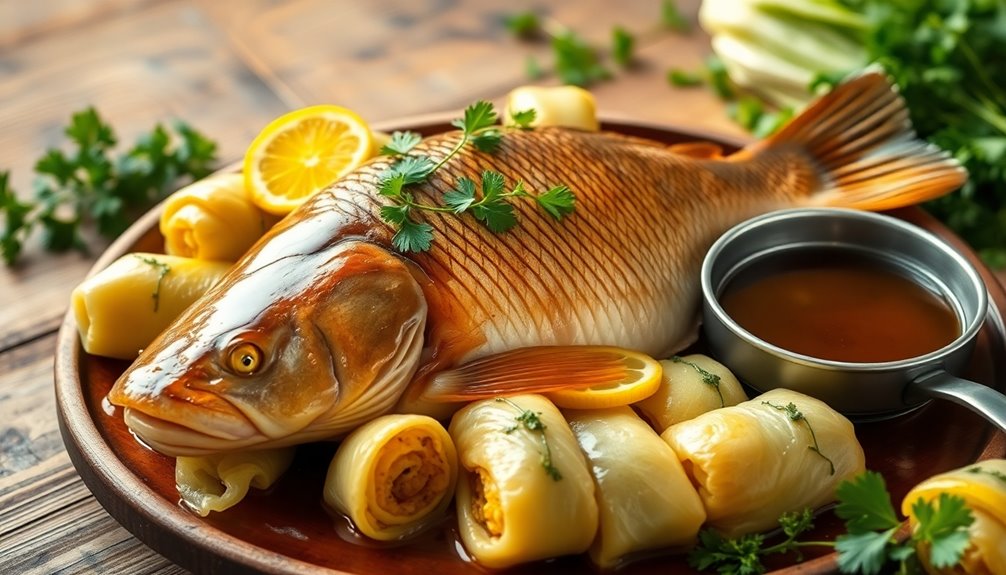
While exploring the rich flavors of stuffed carp, you'll discover a delightful blend of tradition and nutrition.
This dish not only showcases the versatility of carp but also highlights the importance of fresh ingredients like sautéed onions, garlic, and spices. A sprinkle of salt and pepper enhances the taste, while a splash of white wine adds depth to the filling.
Cooking methods, whether steaming, boiling, or baking, ensure the fish is tender and flavorful. Served with a creamy lemon-butter sauce, it elevates the dish further, making it a true culinary delight.
Embracing this traditional recipe connects you to various cultures and offers a healthy, protein-packed meal that's sure to impress your family and friends.
Enjoy every bite!
Frequently Asked Questions
Why Is My Stuffed Cabbage Meat Tough?
If your stuffed cabbage meat's tough, it's likely you've overcooked the filling or the leaves, causing dryness.
Using lean meats without enough fat can lead to a similar issue. Not seasoning the meat well beforehand might also contribute to toughness.
Additionally, if you packed the filling too tightly, it restricts moisture circulation.
Lastly, cooking at too high a temperature can create a hard outer layer while leaving the inside undercooked.
Can You Use the Whole Head of Cabbage?
Using a whole head of cabbage is like opening a treasure chest of culinary possibilities. Yes, you can absolutely use it!
Blanching the entire head softens the leaves, making them easier to roll without tearing. Plus, it lets you tap into the tender inner leaves for filling.
Just make sure you've got enough filling ready, as a large head can give you 20 or more leaves for some delicious stuffed creations.
How Do You Peel Cabbage for Stuffed Cabbage?
To peel cabbage for your recipe, start by selecting a large, fresh head. Remove any damaged outer leaves and cut out the core with a sharp knife.
Blanch the whole head in boiling salted water for about 3-5 minutes to soften the leaves. After blanching, gently separate the leaves using your hands or a large spoon.
If the inner leaves are still tough, return the cabbage to the boiling water for another minute or two.









